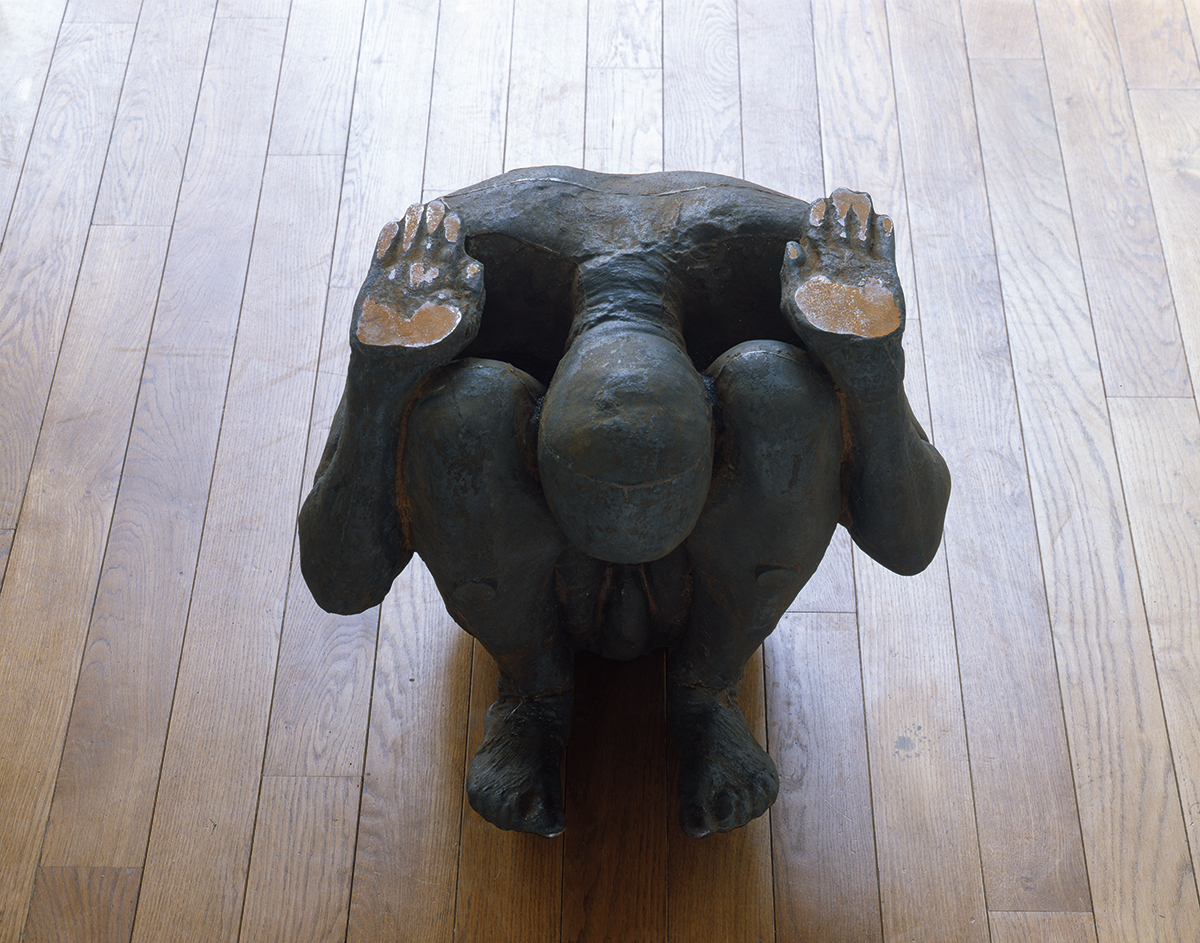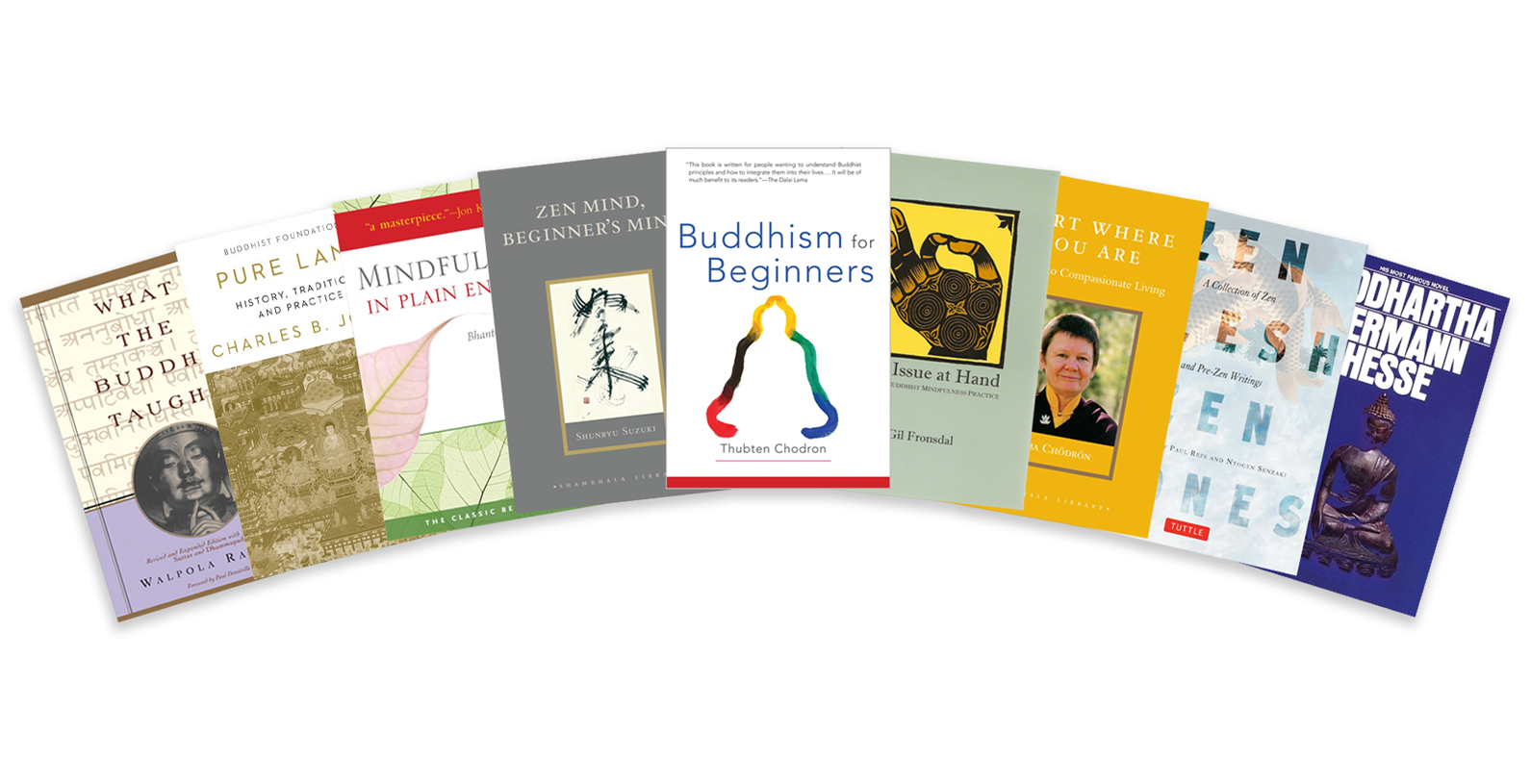Lean in to the Suffering
Sister Clear Grace Dayananda left the monastery, packed her life into a little van, and went out into the world to meet people where they are and where they are suffering. Here, she considers khanti, the paramita of forbearance, and...

Sister Clear Grace Dayananda left the monastery, packed her life into a little van, and went out into the world to meet people where they are and where they are suffering. Here, she considers khanti, the paramita of forbearance, and the work it requires.

“Compound I,” 1996. Sculpture by Antony Gormley. Cast iron. 63.5 x 66 x 66 cm. Installation view, Galerie Xavier Hufkens, Brussels, Belgium.
“Patient endurance,” we are taught in the Dhammapada, is “the foremost austerity.” Patience, endurance, forbearance, tolerance, acceptance, forgiveness—these are just a few of translations of the Pali term khanti (Sanskrit, ksanti), each subtly different from the others. Even scholars have difficulty finding consensus on khanti’s complex meaning. And across traditions, khanti is explained through different means: narrative episodes, hypothetical scenarios, philosophical debates, and by inclusion in didactic lists.
With khanti, in the face of fear and dread, we remain still.
Anytime we attempt to translate a concept that originated in an ancient and foreign tongue, there is a danger of superimposing our Western understanding or injecting ideologies prevalent in the American mindfulness movement. Individuals habitually attach their own implications, experiences, beliefs, and emotional responses, which go beyond the literal definition. For this reason, I recommend we attempt to disentangle our intellectual understanding of khanti from how we actually relate to it in practice.
Contemporary practitioners sometimes phrase their understanding of khanti as “letting go.” Put this way, it might be easy to understand khanti as becoming numb, shrugging off oppressive situations or putting up with them until they go away. This “letting go” can suggest simply accepting that suffering is part of life, even surrendering to it. There is a persistent idea that as we move closer to the path of awakening, we turn away from the ways of the world. But what if that’s not it at all? What if, instead of turning away from the world, we can come to see the world—truly, intimately—and, from that place of clarity, bring about great transformation and healing?
To develop khanti, one must possess two basic motives: first, one must have a wholesome desire to attain peace and freedom from suffering for oneself; second, through compassion, one must have a desire to bring benefit for the harmony and welfare of others. So khanti is not only the development of mental habits that purify the mind of negative states like anger, ill will, or opposing views, but also the concurrent cultivation of positive emotions and feelings toward others, such as metta and goodwill.
Through khanti, our spiritual practice and meditation begin to bear great fruit. The mind becomes concentrated and free from external distractions. Formations appear as impermanent, and we recognize them as suffering. We begin to see all of the factors of existence, all of our “I” making and “mine” making start to appear without agency. Khanti is more than an inward concept practiced by way of introspection—it is also an action to be enacted every day. In all life situations, whether agreeable or disagreeable, khanti is unconditional.
The innumerable obstacles, both physical and psychological, that hinder our practice are subdued through the power of khanti. For those established in restraint, it is a source of constancy; in development of noble qualities, it is the tool of the good. In the stillness in our heart and mind, we begin to loosen our grip, both on the habitual ways in which we create further suffering and the ways we identify these things to be “me” or “mine.” We start to see and understand that greed is our very nature, that the world rests on suffering. Clarity, wisdom, and compassion are ignited, motivating our desire for inner and outer peace.
A person who develops khanti might be fierce, with strength of character, wisdom, vision, courage, dignity, and equanimity. A person developed in khanti possesses a strong mind, full of spiritual inspiration and zeal, that cannot be taken away by life’s adversities. Those who practice khanti are not afflicted in this world, and they refrain from actions that will lead to affliction in the life to come.
Cultivation
Cultivating khanti is foundational to establishing steadiness and sure-footedness on the path to awakening. Rather than shaking, sinking, or reacting to the causes and conditions that give rise to the turbulence of existence, one who has cultivated khanti is unaffected by rage, despair, or mental obstructions. We can see things as they are, without pity for self or others, and without clinging to the multiplicity of ways we might wish the situation were different. We might even begin to develop gratitude for the challenges that provide opportunities to cultivate our practice, knowing that these very moments become the causes of awakening.
Precisely because of life’s adversity, it is important to cultivate the great power and virtue of khanti. In time, it will cut through arrogance and ingratitude, helping us to see all the conditions present in the situation—and in ourselves—that create suffering. It paves the path from resistance to acceptance. It also allows us to be more actively present for the benefit of self and others, to move away from doing evil and causing harm and toward doing good and benefiting others. When we don’t resist or cling to our views about these difficulties, we have a greater freedom and capacity to show up for them, which then allows us the space to create change through wisdom.
A common practice of those training in the development of khanti is to voluntarily take up suffering to cleanse the mind of passions, attachments, lust, hate, and delusion. The Buddha gave us a clear example of how to practice khanti in the face of fear and dread: before his enlightenment, he entered remote jungle thickets, dwelling there to know and understand where the subtle residue of defilements might still be present. The Buddha said we must train to purify our bodies and minds of hindrances and defilements so they do not give rise to dread and fear. When they do arise, we should examine them. What is this fear and dread? Why do we expect it? What residue of defilements gives rise to this fear and dread? What if we subdue it? With khanti, in the face of fear and dread, we remain still. Whatever state we are in, we remain in that state, carefully observing all its parts until dread and fear are subdued.
The next step in cultivating khanti is to come back, pick up that suffering, and look deeply at it so that understanding, healing, and transformation can begin. It’s a process of effacement, of rubbing out the ways in which we identify suffering with who we are.
Leaning In
Bhikkhus! What are the asavas that are to be removed through forbearance [khanti]?
Bhikkhus! In this teaching, the bhikkhu, reflecting properly, can endure cold, heat, hunger, thirst, gadflies, mosquitoes, wind, heat of the sun, snakes, scorpions, and lice. He can endure ill-spoken and unwholesome words. He has the nature of being able to endure severe, cruel, excruciatingly sharp, disagreeable, unpleasant, deadly, and painful sensations that arise in the body.
Bhikkhus! Asavas and other destructive and burning defilements may arise in the bhikkhu who cannot endure such painful sensations. Those asavas and other destructive and burning defilements do not arise in the bhikkhu who endures such painful sensations with proper reflection. Bhikkhus! These are called the asavas that are to be removed through forbearance.
—from Sabbasava Sutta, “Discourse on All Asavas”
(Majjhima Nikaya 2)
Let’s think about khanti as an active leaning-in to suffering—rubbing up against, bearing witness, and maintaining a steady heart and mind in the presence of hardship, challenges, fear, and difficult people. Khanti is a difficult but necessary purification practice that helps us to develop a response to suffering; it allows us to suffer differently, to suffer less, and to use the energy of suffering as a great power than can create immediate transformation and healing in ourselves, others, society, and the world. It requires great desire, volition, and energy. This leaning-in must be done with a concentrated mindfulness that sees all the parts without a strong attachment to views. No matter where we stand in our views, or how much we long for justice, we can choose to look deeply into the state of the world and its suffering, our history, its systems, society, community, and beliefs.
Khanti gives us the space to allow forgiveness, healing, understanding, love, and the necessary connection to meet people where they are. For those who have endured and continue to endure systemic racism, marginalization, cultural erasure, and transracial trauma, khanti has been, in many ways, a rite of passage. Meditation and the spiritual power of the dharma turn us from an inward-facing journey of untangling knots and gaining freedom from bondage toward a greater desire to share that liberation. Social engagement becomes a fundamental part of our efforts on behalf of all beings.
As an African American monk who arrived on the dharma path by way of intersectionality, the desire for transformation, healing, complete liberation, interconnectedness, and beloved community are passions. One way I’ve chosen to outwardly embody this desire for collective liberation is through the practice of pilgrimage.
As a queer African American, Buddhism has often seemed inaccessible; it had an elite whiteness to it that was afraid to lean in to the work necessary for us all to practice in sangha, in the beloved community. How was the dharma being made accessible to all? If our dharma communities are unsure how to embrace, or just don’t have the capacity to make room for, disability inclusion, LGBTQIA+, BIPOC/BAME communities, and those outside of dharma circles, then where, I wondered, is the bodhisattva path than can? And where was the Buddha when I was growing up as a little Black girl? Where were the monks? Was meditation something in the suburbs, like karate lessons and dance recitals?
In the monastery, I felt called to walk in communities where you might not find a monk, to meet the people where they are. Last year, I decided to do just that. I started traveling the country in my own mobile monastery, a renovated Chevy van named “the Great Aspiration.” I am supported along the way by the people I meet, and I in turn share with them the great freedom I have come to know.
This leaning in and choosing to look into suffering isn’t masochism. It comes from a desire to alleviate suffering, to understand it, and to break free from the bonds of it, for myself and for all beings.
My journey has, for the most part, brought insight, healing, connection, and great loving support, but my pilgrimage through this highly racialized country has not been without its moments of adversity, fear, violence, and injustice. I have visited detention centers, churches, assisted living, housing communities, homeless encampments, migrant camps, reservations, trailer communities, dollar stores, and laundromats, and through all of it, strong cultivation of tolerant endurance and patience has been a necessity.
During my pilgrimage, I have had many opportunities to actively practice leaning in to fear and suffering. I often engage in the practice of walking meditation in cemeteries to contemplate impermanence and to foster healing and gratitude. Once, while walking in an old southern cemetery, I came upon a statue, about ten feet tall, that stood above a Confederate monument. The subject of that statue represents, for many, a hope that the Confederacy will rise again. Statues like this one have been at the center of political unrest, deadly protests, and a great divide of racial hatred and ill will.
At the moment I saw the statue, I became aware of great pain and intense fear that threatened to pour in and overwhelm me. Knowing how the mind craves and clings to suffering, and how it uses suffering to shore up the illusion of a separate, permanent self, I chose to sit with discernment and alert mindfulness at the foot of that statue and lean in to all that was there, and was not there, for myself, my country, my ancestors, all of us standing on opposing sides of its history. Fear arose, and I leaned in to the fear. I observed and felt it, waiting for it fall away. Engaging the energy of khanti created space for transformation and healing, for compassion and understanding to rise in the midst of great suffering. I sat in full awareness, finding, for the moment, a place of ease beneath that statue, finding peace with its object, and finding space and freedom from either needing it to remain or wanting it to be torn down. This leaning in and choosing to look into suffering isn’t masochism. It comes from a desire to alleviate suffering, to understand it, and to break free from the bonds of it, for myself and for all beings.
Facing Suffering
“If I get angry with him for his treachery, my morality will break. I must not get angry with him. If I look at him, he will explode. Even if he hits me, I will not get angry at him or look at him.” Thinking this, he closed his eyes, and completing the perfection of resolution, he placed his head between his hands and lay perfectly motionless. The pure Naga king did not get angry for fear of violating the moral precepts, and did not open his eyes. The Great Being felt no anger even though he suffered such pain. (Bhuridattanagaraja Jataka)
The opposite of khanti is anger or ill will. Khanti is its antidote; it is the negation of anger, without conditions placed on anyone or anything. It is the state of not being angry. Anger compromises our morality. It is not only monastics who practice morality, restraint, and renunciation—lay practitioners can also train ardently, with a true desire to break free of the prisons we create for ourselves through anger, dis-ease, and impatience. To quell anger, we must be possessed of a true desire break the bonds that tie us; to develop khanti, we should cultivate a foundation of doing good by engaging earnestly with the precepts. We should also cultivate metta, the spiritual inspiration of khanti. Metta replaces anger. Metta is how we respond to the world when we face great difficulty—it moves khanti from an inward practice to one of cultivation of goodwill for others, for the world.
The importance of engaging khanti in the face of suffering recently came into sharp focus for me upon hearing the “not guilty of all counts” verdict in a high-profile court case. Those five words stirred an ancestral and personal rumble of anger, despair, grief, and confusion. Black people have been sitting in the courtroom for centuries, hoping for a different outcome, awaiting our time for justice, waiting to know that we matter. As a Black person, hearing “not guilty of all counts”—words that seem to echo endlessly—touched a deep and excruciating historical wound.
That verdict validated a view of the great divide in our society and of a system that continues to harm and disregard Black people and those who dare to stand for equity and justice. It was a disheartening reminder that we are governed by a system that continues to escalate violence and injustice.
I have a great desire for liberation from these very sufferings; as a monastic who has chosen to take up the discipline and lineage of the buddhas and bodhisattvas, I hold an aspiration to cut the ties that bind and to see through suffering and the ways in which I experience it. This desire gives rise to virya, or energy, which powers khanti by sustaining concentration, alert mindfulness, endurance, tolerant patience, and a desire to deeply understand and be free from suffering.
When we encounter something like that verdict, seemingly real emotions, feelings, perceptions, and mental formations, as well as our consciousness and our body, are painfully awakened. Our instinct is to crave, to cling—we instinctively attach to these feelings, validate them, identify with them, make them our own, and take up a view. Choosing to lean in before these feelings are activated, at the moment of encounter, is a compassionate act, an expression of the desire to break through and understand suffering for oneself, the world, and all beings. This is khanti—a disciplined, tolerant patience in the moments within the moment. It requires an intimate relationship with suffering: knowing how we suffer, knowing the point at which suffering arises, and clearly seeing how we chase and feed the formations that come quickly thereafter.
Hearing the verdict is suffering; wanting it to be different, feeding the formations, and making it mine are suffering’s causes. Leaning in means willingly, mindfully, and in full awareness, laying down that painful feeling. We can choose to lay it down for ourselves, our ancestors, the earth, and for all beings.
In the Sarabhanga Jataka, Sakka asked the Buddha, “Holy sir, declare to us the blessing to be found in this patience.” The Buddha replied, “Not even a strong army is as advantageous in a war as khanti is to a good man during hostilities.” When we have made the right effort to put aside our painful feeling and to engage in khanti, we create space to see more of its parts. Leaning in is required both at the moment suffering arises and later, when we have greater capacity to investigate the suffering and cultivate khanti with it.
We have plenty of opportunity, with the state of our world as it is, to take up the practice of khanti; in every moment, we can see what residue of fear, anger, attachment, and craving is left in us.
The very nature of existence is craving. In order to see where craving falls apart, this painful, difficult, unjust, unsatisfactory, inconclusive, and unstable quality must be understood. We must see through it: where it touches us, where things are felt, where we are grasping at it, where and how we identify with it, the stories we were told about it. Through khanti, through this leaning in, we find a place to work with the suffering. Seeing all its conditions, we can be more skillful at working with it for ourselves and the welfare of others. Khanti is not passive; it has energy and strength to drive out desire with wisdom, challenging our self-clinging and the delusion of building a self in opposition to others. It gives us a genuine devotion toward compassion, a way beyond the view of “self” and “opposing forces.”
This time is uncertain, unprecedented. We are faced with injustices of all kinds, with lack of inclusion and equality for all, political violence, poverty, police violence; we are all affected by the inequality in resources such as health care, education, job opportunities; we are all touched by the pandemic, all the victims of natural disasters. Through khanti, we come to see the world and how the eight worldly winds—pleasure and pain, gain and loss, praise and blame, fame and disrepute—might pervade our lives.
Suffering is everywhere we look. By practicing khanti, we can take that suffering and make good use of it. We can create transformation and healing in ourselves and in the world. We can show up with an ever-enduring love, like that of the Buddha—overflowing with compassion, utterly without fear.

 UsenB
UsenB 
































